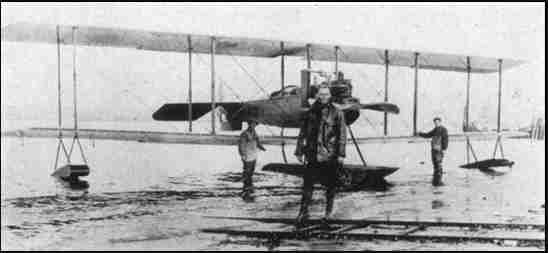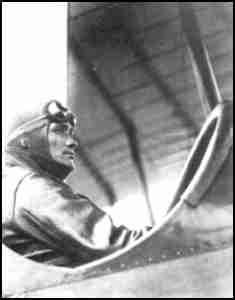
-1970 |
 |
|
Here we see the Army's "Incredible Smith," with one of the biplane seaplanes he flew. He is EB Brig.
Gen Albert D. Smith, now living in California. November, 1958 Number 60 |
|
We are indebted to Horace Tuttle for sending in a February, 1945 copy of the Coronet which presented a 7-page story of the exploits of Albert D. Smith who was called the "Army's Number-One Smith." Eb Brig Gen. Albert D. Smith ret, now lives at Balboa Island, California. Smith had his first taste as an infantry private and was promptly sent to the Philippines to battle the Moros who were on the warpath. He landed back at San Francisco in 1906 in time to help fight the fires which accompanied the great earthquake. He left the army in 1907 to run his own ranch in Montana but his interest in airplanes lured him away, and in 1911 he flew his first plane which he and a friend built. That first flight ended in a crash landing, but in the years that followed he piled up thousands of hours in the air as a skilled pilot. He is the holder of Aero Club license #354. A. D. became an army pilot and fought in both world wars, and many were his exploits and close calls in and out of srvice. As a corporal, he won the American hydroplane duration record of 8 hours and 42 minutes on February 19, 1916. He is also credited with being the first man to make radio connections between plane and plane, and plane and ground. He was chosen by Arnold as a trouble shooter whenever the army needed a man to do an impossible job. Im March, 1918, Smith crashed at Wright Field, Dayton and was seriously injured, but he refused to stay long out of service. In 1919 he joined Col. H. H. Arnold's Northwestern Forest Fire Patrol which was undertaking a pioneering task to preserve our national forests, and his daring flights took him through the canyons and rough country. Because he never allowed his old injuries time to heal, he was let out of service for physical disability in 1923. After working a small property in California for a time, he organized Scenic Airways which flew tourists down into the Grand Canyon. Still later he joined an airline which merged with others to form TWA. He resigned a fine job with TWA in 1940 to go back into the Army, and he became operations officer at Albuquerque Air Base. Following other training assignments, Smith, now a Colonel, was chosen by Arnold to man a northern air base from which planes were flown to Europe. He was also sent to help Bernt Balchen conquer Greenland and keep it free of Germans. After A. D. had done such a good job in Greenland, General Arnold sent him to a new base being built right under the nose of the enemy, and he was likewise put back on flying status and made a Brigadier General. During his many flying years, A. D. Smith, the Army's number-one Smith, performed many rescues and conquered many difficult projects. November, 1958 Number 60 |
 |
who commanded a flight of five JN-4H aircraft on a transcontinental mapping flight at the end of 1918. The History of North Island, San Diego, California By Elretta Sudsbury |
|
You may read the whole entry on the Aviation AeroWeb History page by clicking on: Albert D. Smith You may want to use the "Find" function on "Smith" I invite you to browse the hompage of the site by clicking on Aviation Enthusiast Corner |
|
From The Early Birds of Aviation Roster of Members January 1, 1993 If you have any information on this Early Bird, please contact me. E-mail to Ralph Cooper Back 

|